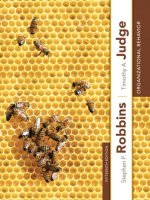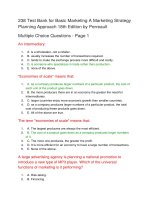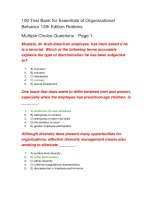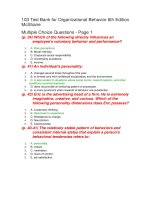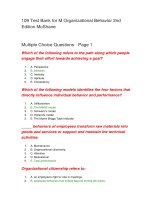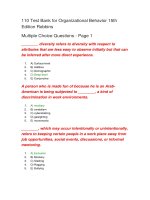Preview Organizational Behavior, 18th Edition by Stephen P. Robbins Timothy A. Judge (2018)
Bạn đang xem bản rút gọn của tài liệu. Xem và tải ngay bản đầy đủ của tài liệu tại đây (40.87 MB, 284 trang )
Robbins
Judge
MyLab
ORGANIZATIONAL BEHAVIOR
™
Improving Results
A proven way to help individual students achieve
the goals that educators set for their course.
Engaging Experiences
Dynamic, engaging experiences that personalize
and activate learning for each student.
An Experienced Partner
From Pearson, a long-term partner
with a true grasp of the subject,
excellent content, and an eye on the
future of education.
www.pearson.com
18TH
EDITION
Stephen P. Robbins
|
Timothy A. Judge
ORGANIZATIONAL
BEHAVIOR
18TH EDITION
ORGANIZATIONAL
BEHAVIOR
18TH EDITION
Stephen P. Robbins
—San Diego State University
Timothy A. Judge
—The Ohio State University
New York, NY
A01_ROBB9329_18_SE_FM.indd 1
29/09/17 11:51 pm
Vice President, Business, Economics, and UK Courseware:
Donna Battista
Director of Portfolio Management: Stephanie Wall
Senior Portfolio Manager: Kris Ellis-Levy
Editorial Assistant: Hannah Lamarre
Vice President, Product Marketing: Roxanne McCarley
Senior Product Marketer: Becky Brown
Product Marketing Assistant: Marianela Silvestri
Manager of Field Marketing, Business Publishing:
Adam Goldstein
Field Marketing Manager: Nicole Price
Vice President, Production and Digital Studio,
Arts and Business: Etain O’Dea
Director of Production, Business: Jeff Holcomb
Managing Producer, Business: Melissa Feimer
Content Producer: Claudia Fernandes
Operations Specialist: Carol Melville
Design Lead: Kathryn Foot
Manager, Learning Tools: Brian Surette
Content Developer, Learning Tools: Lindsey Sloan
Managing Producer, Digital Studio, Business MyLabs:
Ashley Santora
Managing Producer, Digital Studio, Arts and Business:
Diane Lombardo
Digital Studio Producer: Monique Lawrence
Digital Studio Producer: Alana Coles
Project Management: Thistle Hill Publishing Services
Composition: Cenveo® Publisher Services
Interior and Cover Design: Cenveo® Publisher Services
Cover Art: Ondrej Prosicky/Shutterstock
Printer/Binder: LSC Communications, Inc.
Cover Printer: Phoenix Color/Hagerstown
Microsoft and/or its respective suppliers make no representations about the suitability of the information contained in the
documents and related graphics published as part of the services for any purpose. All such documents and related graphics
are provided “as is” without warranty of any kind. Microsoft and/or its respective suppliers hereby disclaim all warranties and
conditions with regard to this information, including all warranties and conditions of merchantability, whether express, implied
or statutory, fitness for a particular purpose, title and non-infringement. In no event shall Microsoft and/or its respective suppliers
be liable for any special, indirect or consequential damages or any damages whatsoever resulting from loss of use, data or profits,
whether in an action of contract, negligence or other tortious action, arising out of or in connection with the use or performance
of information available from the services.
The documents and related graphics contained herein could include technical inaccuracies or typographical errors. Changes are
periodically added to the information herein. Microsoft and/or its respective suppliers may make improvements and/or changes
in the product(s) and/or the program(s) described herein at any time. Partial screen shots may be viewed in full within the software
version specified.
Microsoft® and Windows® are registered trademarks of the Microsoft Corporation in the U.S.A. and other countries. This book is
not sponsored or endorsed by or affiliated with the Microsoft Corporation.
Copyright © 2019, 2017, 2015 by Pearson Education, Inc. or its affiliates. All Rights Reserved. Manufactured in the United States
of America. This publication is protected by copyright, and permission should be obtained from the publisher prior to any prohibited
reproduction, storage in a retrieval system, or transmission in any form or by any means, electronic, mechanical, photocopying,
recording, or otherwise. For information regarding permissions, request forms, and the appropriate contacts within the Pearson
Education Global Rights and Permissions department, please visit www.pearsoned.com/permissions/.
Planet earth icon courtesy of Jemastock/Alamy Stock Vector. All other acknowledgments of third-party content appear on the
appropriate page within the text.
PEARSON, ALWAYS LEARNING, and MYLAB are exclusive trademarks owned by Pearson Education, Inc., or its affiliates in the U.S.
and/or other countries.
Unless otherwise indicated herein, any third-party trademarks, logos, or icons that may appear in this work are the property of
their respective owners, and any references to third-party trademarks, logos, icons, or other trade dress are for demonstrative or
descriptive purposes only. Such references are not intended to imply any sponsorship, endorsement, authorization, or promotion
of Pearson’s products by the owners of such marks, or any relationship between the owner and Pearson Education, Inc., or its
affiliates, authors, licensees, or distributors.
Library of Congress Cataloging-in-Publication Data
Names: Robbins, Stephen P., 1943- author. | Judge, Tim, author.
Title: Organizational behavior / Stephen P. Robbins, San Diego State
University, Timothy A. Judge, The Ohio State University.
Description: Eighteenth edition. | New York, NY : Pearson Education, [2019] |
Includes bibliographical references and index.
Identifiers: LCCN 2017043368 | ISBN 9780134729329 (hardcover) | ISBN
0134729323 (hardcover)
Subjects: LCSH: Organizational behavior.
Classification: LCC HD58.7 .R62 2019 | DDC 658.3--dc23
LC record available at />1 17
ISBN 10:
0-13-472932-3
ISBN 13: 978-0-13-472932-9
A01_ROBB9329_18_SE_FM.indd 2
29/09/17 11:51 pm
Brief Contents
Preface xxiii
1Introduction
1
What Is Organizational Behavior? 2
2 The Individual
2
3
4
5
6
7
8
Diversity in Organizations 42
Attitudes and Job Satisfaction 74
Emotions and Moods 102
Personality and Values 140
Perception and Individual Decision Making 176
Motivation Concepts 214
Motivation: From Concepts to Applications 252
3 The Group
9
10
11
12
13
14
15
Foundations of Group Behavior 286
Understanding Work Teams 322
Communication 354
Leadership 392
Power and Politics 434
Conflict and Negotiation 470
Foundations of Organization Structure 506
4 The Organization System
16
17
18
Organizational Culture 542
Human Resources Policies and Practices 580
Organizational Change and Stress Management 622
Appendix Research in Organizational Behavior 667
Comprehensive Cases 674
Glossary 688
Name Index 698
Organization Index 717
Subject Index 720
iii
A01_ROBB9329_18_SE_FM.indd 3
29/09/17 11:51 pm
This page intentionally left blank
Contents
Preface xxiii
1
Introduction
1 What Is Organizational Behavior? 2
The Importance of Interpersonal Skills 5
Management and Organizational Behavior 6
Management Roles 7 • Management Skills 8 • Effective versus Successful
Managerial Activities 8
Complementing Intuition with Systematic Study 11
Big Data 11
Myth or Science? Management by Walking Around Is the Most Effective
Management 12
Disciplines That Contribute to OB 15
Psychology 15 • Social Psychology 16 • Sociology 16 •
Anthropology 16
There Are Few Absolutes in OB 16
Challenges and Opportunities 17
Economic Pressures 18 • Continuing Globalization 18 • Workforce
Demographics 20
Personal Inventory Assessments Multicultural Awareness Scale 20
Workforce Diversity 21 • Customer Service 21 • People Skills 21 •
Networked Organizations 22 • Social Media 22 • Employee Well-Being
at Work 22 • Positive Work Environment 23 • Ethical Behavior 24
An Ethical Choice Vacation: All I Ever Wanted 25
Coming Attractions: Developing an OB Model 26
An Overview 26 • Inputs 26 • Processes 27 • Outcomes 27
Career OBjectives What do I say about my termination? 29
Employability Skills 32
Employability Skills That Apply across Majors 33
Summary 34
v
A01_ROBB9329_18_SE_FM.indd 5
29/09/17 11:51 pm
vi
Contents
Implications for Managers 34
Point/Counterpoint The Battle of the Texts 35
Questions for Review 36
Experiential Exercise Managing the OB Way 36
Ethical Dilemma There’s a Drone in Your Soup 37
Case Incident 1 Apple Goes Global 37
Case Incident 2 Big Data for Dummies 38
2
The Individual
2 Diversity in Organizations 42
Diversity 45
Demographic Characteristics 45 • Levels of Diversity 46
An Ethical Choice Affirmative Action for Unemployed Veterans 47
Discrimination 47
Stereotype Threat 48
Personal Inventory Assessments Intercultural Sensitivity Scale 49
Discrimination in the Workplace 49
Biographical Characteristics 50
Age 50
Myth or Science? Bald Is Better 51
Sex 52 • Race and Ethnicity 53 • Disabilities 54 • Hidden Disabilities 55
Other Differentiating Characteristics 56
Tenure 56 • Religion 56 • Sexual Orientation and Gender Identity 57
Career OBjectives Should I come out at work? 58
Cultural Identity 59
Ability 59
Intellectual Abilities 60 • Physical Abilities 61
Implementing Diversity Management Strategies 62
Attracting, Selecting, Developing, and Retaining Diverse Employees 62 •
Diversity in Groups 63 • Expatriate Adjustment 64 • Effective Diversity
Programs 64
Summary 65
Implications for Managers 65
Point/Counterpoint Affirmative Action Programs Have Outlived Their Usefulness 66
Questions for Review 67
Experiential Exercise Differences 67
Ethical Dilemma Voiding the “License to Discriminate” 68
Case Incident 1 Can Organizations Train Diversity? 68
Case Incident 2 The Encore Career 69
A01_ROBB9329_18_SE_FM.indd 6
29/09/17 11:51 pm
vii
Contents
3 Attitudes and Job Satisfaction 74
Attitudes 77
Attitudes and Behavior 78
Job Attitudes 79
Job Satisfaction and Job Involvement 79
An Ethical Choice Office Talk 80
Organizational Commitment 80 • Perceived Organizational Support 81 •
Employee Engagement 81 • Are These Job Attitudes All That Distinct? 82
Job Satisfaction 83
Measuring Job Satisfaction 83 • How Satisfied Are People in Their Jobs? 84
What Causes Job Satisfaction? 85
Job Conditions 86 • Personality 86
Personal Inventory Assessments Core Self-Evaluation (CSE) Scale 86
Pay 87 • Corporate Social Responsibility (CSR) 87
Outcomes of Job Satisfaction 88
Job Performance 88 • Organizational Citizenship Behavior (OCB) 88 •
Customer Satisfaction 89 • Life Satisfaction 89
Career OBjectives How can I make my job better? 90
The Impact of Job Dissatisfaction 90
Counterproductive Work Behavior (CWB) 91
Myth or Science? Happy Workers Means Happy Profits 93
Managers Often “Don’t Get It” 93
Summary 94
Implications for Managers 94
Point/Counterpoint Employer–Employee Loyalty Is an Outdated Concept 95
Questions for Review 96
Experiential Exercise Job Attitudes Situational Interview 96
Ethical Dilemma Tell-All Websites 97
Case Incident 1 Self-Service Kiosks: From People to Robots 97
Case Incident 2 Job Crafting 98
4 Emotions and Moods 102
What Are Emotions and Moods? 105
The Basic Emotions 106
Myth or Science? Smile, and the Work World Smiles with You 106
Moral Emotions 107 • The Basic Moods: Positive and Negative
Affect 107 • Experiencing Moods and Emotions 108 • The Function
of Emotions 110
Sources of Emotions and Moods 111
Personality 111 • Time of Day 111 • Day of the Week 113 • Weather 113
A01_ROBB9329_18_SE_FM.indd 7
29/09/17 11:51 pm
viii
Contents
Stress 113 • Social Activities 113 • Sleep 115 • Exercise 115 • Age 115 •
Sex 115
Emotional Labor 116
Affective Events Theory 118
Emotional Intelligence 119
An Ethical Choice Should Managers Use Emotional Intelligence (EI) Tests? 120
Personal Inventory Assessments Emotional Intelligence Assessment 121
Emotion Regulation 121
Emotion Regulation Influences and Outcomes 121 • Emotion Regulation
Techniques 122 • Ethics of Emotion Regulation 123
OB Applications of Emotions and Moods 124
The Selection Process 124 • Decision Making 124 • Creativity 125 •
Motivation 125 • Leadership 125 • Negotiation 126 • Customer
Service 126 • Work-Life Satisfaction 126
Career OBjectives How do I turn down the volume on my screaming boss? 127
Deviant Workplace Behaviors 127 • Safety and Injury at Work 128
Summary 128
Implications for Managers 128
Point/Counterpoint Sometimes Yelling Is for Everyone’s Good 129
Questions for Review 130
Experiential Exercise Mindfulness at Work 130
Ethical Dilemma Data Mining Emotions 131
Case Incident 1 Managers Have Feelings, Too! 132
Case Incident 2 When the Going Gets Boring 133
5 Personality and Values 140
Personality 143
What Is Personality? 143
Career OBjectives How do I ace the personality test? 144
Personal Inventory Assessments Core Five Personality Dimensions 145
Personality Frameworks 145
The Myers-Briggs Type Indicator 146 • The Big Five Personality
Model 146 • The Dark Triad 150
Other Personality Attributes Relevant to OB 152
Core Self-Evaluations (CSEs) 152 • Self-Monitoring 153
Myth or Science? We Can Accurately Judge Individuals’ Personalities
a Few Seconds after Meeting Them 154
Proactive Personality 154
Personality, Job Search, and Unemployment 155
Personality and Situations 156
Situation Strength Theory 156 • Trait Activation Theory 157
A01_ROBB9329_18_SE_FM.indd 8
29/09/17 11:51 pm
ix
Contents
Values 158
The Importance and Organization of Values 159 • Terminal versus
Instrumental Values 159 • Generational Values 159
An Ethical Choice Do You Have a Cheating Personality? 160
Linking an Individual’s Personality and Values to the Workplace 161
Person–Job Fit 161 • Person–Organization Fit 162 • Other Dimensions
of Fit 162
Cultural Values 163
Hofstede’s Framework 163 • The GLOBE Framework 164 • Comparison of
Hofstede’s Framework and the GLOBE Framework 165
Summary 165
Implications for Managers 165
Point/Counterpoint Millennials Are More Narcissistic Than Their Parents 166
Questions for Review 167
Experiential Exercise Your Best Self 167
Ethical Dilemma From Personality to Values to Political Ideology in Hiring 168
Case Incident 1 On the Costs of Being Nice 169
Case Incident 2 The Clash of the Traits 170
6 Perception and Individual Decision Making 176
What Is Perception? 179
Factors That Influence Perception 179
Person Perception: Making Judgments About Others 181
Attribution Theory 181
Career OBjectives So what if I’m a few minutes late to work? 183
Common Shortcuts in Judging Others 184 • Specific Applications
of Shortcuts in Organizations 185
Myth or Science? All Stereotypes Are Negative 186
The Link Between Perception and Individual Decision Making 187
Decision Making in Organizations 187
The Rational Model, Bounded Rationality, and Intuition 187 • Common
Biases and Errors in Decision Making 189
Influences on Decision Making: Individual Differences and Organizational
Constraints 193
Individual Differences 193 • Organizational Constraints 195
What About Ethics in Decision Making? 196
Three Ethical Decision Criteria 196 • Lying 198
An Ethical Choice Choosing to Lie 199
Creativity, Creative Decision Making, and Innovation in Organizations 199
Creative Behavior 200 • Causes of Creative Behavior 201
Personal Inventory Assessments Creativity Scale 202
Creative Outcomes (Innovation) 203
A01_ROBB9329_18_SE_FM.indd 9
29/09/17 11:51 pm
x
Contents
Summary 204
Implications for Managers 204
Point/Counterpoint Implicit Assessment 205
Questions for Review 206
Experiential Exercise Mafia 206
Ethical Dilemma Cheating Is a Decision 207
Case Incident 1 Warning: Collaboration Overload 208
Case Incident 2 Feeling Bored Again 208
7 Motivation Concepts 214
Motivation Defined 217
Early Theories of Motivation 218
Hierarchy of Needs Theory 218 • Two-Factor Theory 219 • McClelland’s
Theory of Needs 220
Career OBjectives Why won’t he take my advice? 222
Contemporary Theories of Motivation 223
Self-Determination Theory 223
Myth or Science? Helping Others and Being a Good Citizen Is Good for
Your Career 224
Goal-Setting Theory 224
Other Contemporary Theories of Motivation 228
Self-Efficacy Theory 228 • Reinforcement Theory 230
An Ethical Choice Motivated by Big Brother 231
Expectancy Theory 232
Personal Inventory Assessments Work Motivation Indicator 234
Equity Theory/Organizational Justice 234
Distributive Justice 235 • Procedural Justice 236 • Interactional
Justice 237 • Justice Outcomes 238 • Promoting Justice 239 • Culture
and Justice 239
Job Engagement 240
Integrating Contemporary Theories of Motivation 240
Summary 242
Implications for Managers 242
Point/Counterpoint Goals Get You to Where You Want to Be 243
Questions for Review 244
Experiential Exercise Organizational Justice Task 244
Ethical Dilemma Follies of Reward 245
Case Incident 1 The Demotivation of CEO Pay 245
Case Incident 2 Laziness Is Contagious 246
A01_ROBB9329_18_SE_FM.indd 10
29/09/17 11:51 pm
xi
Contents
8 Motivation: From Concepts to Applications 252
Motivating by Job Design: The Job Characteristics Model 255
The Job Characteristics Model 255
Job Redesign 257
Job Rotation and Job Enrichment 257
Myth or Science? Money Can’t Buy Happiness 258
Relational Job Design 259
Personal Inventory Assessments Diagnosing Poor Performance and Enhancing
Motivation 260
Alternative Work Arrangements 260
Flextime 261 • Job Sharing 263 • Telecommuting 263
Career OBjectives How can I get flextime? 264
Employee Involvement 266
Examples of Employee Involvement Programs 266
Using Rewards to Motivate Employees 267
What to Pay: Establishing a Pay Structure 268 • How to Pay: Rewarding
Individual Employees through Variable-Pay Programs 269
An Ethical Choice Sweatshops and Worker Safety 273
Using Benefits to Motivate Employees 274
Flexible Benefits: Developing a Benefits Package 274
Using Intrinsic Rewards to Motivate Employees 275
Employee Recognition Programs 275
Summary 277
Implications for Managers 277
Point/Counterpoint Face Time Matters 278
Questions for Review 279
Experiential Exercise Developing an Organizational Development and Compensation
Plan for Automotive Sales Consultants 279
Ethical Dilemma You Want Me to Do What? 280
Case Incident 1 We Talk, But They Don’t Listen 280
Case Incident 2 Pay Raises Every Day 281
3
The Group
9 Foundations of Group Behavior 286
Defining and Classifying Groups 288
Social Identity 289 • Ingroups and Outgroups 290 • Social Identity
Threat 291
Stages of Group Development 291
A01_ROBB9329_18_SE_FM.indd 11
29/09/17 11:51 pm
xii
Contents
Group Property 1: Roles 292
Role Perception 293 • Role Expectations 293 • Role Conflict 294 • Role
Play and Assimilation 294
Myth or Science? Gossip and Exclusion Are Toxic for Groups 295
Group Property 2: Norms 296
Norms and Emotions 296 • Norms and Conformity 296 • Norms and
Behavior 297
An Ethical Choice Using Peer Pressure as an Influence Tactic 298
Positive Norms and Group Outcomes 299 • Negative Norms and Group
Outcomes 300 • Norms and Culture 301
Group Property 3: Status, and Group Property 4: Size and Dynamics 301
Group Property 3: Status 301 • Group Property 4: Size and Dynamics 303
Group Property 5: Cohesiveness, and Group Property 6: Diversity 305
Group Property 5: Cohesiveness 305 • Group Property 6: Diversity 306
Personal Inventory Assessments Communicating Supportively 306
Group Decision Making 307
Groups versus the Individual 307 • Groupthink and Groupshift 308
Career OBjectives Can I fudge the numbers and not take the blame? 309
Group Decision-Making Techniques 310
Summary 312
Implications for Managers 312
Point/Counterpoint Diverse Work Groups Are Smarter and More Innovative 313
Questions for Review 314
Experiential Exercise Surviving the Wild: Join a Group or Go It Alone? 314
Ethical Dilemma Is It Okay to Violate a Psychological Contract? 316
Case Incident 1 The Calamities of Consensus 316
Case Incident 2 Intragroup Trust and Survival 317
10 Understanding Work Teams 322
Why Have Teams Become So Popular? 325
Differences Between Groups and Teams 325
Types of Teams 327
Problem-Solving Teams 327 • Self-Managed Work Teams 327 • CrossFunctional Teams 328 • Virtual Teams 328 • Multiteam Systems 329
An Ethical Choice The Size of Your Meeting’s Carbon Footprint 330
Creating Effective Teams 331
Team Context: What Factors Determine Whether Teams Are
Successful? 332 • Team Composition 333
Myth or Science? Team Members Who Are “Hot” Should Make the Play 334
Career OBjectives Is it wrong that I’d rather have guys on my team? 337
Team Processes 338
A01_ROBB9329_18_SE_FM.indd 12
29/09/17 11:51 pm
xiii
Contents
Personal Inventory Assessments Team Development Behaviors 342
Turning Individuals into Team Players 342
Selecting: Hiring Team Players 342 • Training: Creating Team
Players 343 • Rewarding: Providing Incentives to Be a Good Team Player 343
Beware! Teams Aren’t Always the Answer 344
Summary 344
Implications for Managers 345
Point/Counterpoint To Get the Most Out of Teams, Empower Them 346
Questions for Review 347
Experiential Exercise Should You Use Self-Managed Teams? 347
Ethical Dilemma Is It Worth Hiring a Star Instead of a Team Player? 348
Case Incident 1 Trusting Someone You Can’t See 348
Case Incident 2 Smart Teams and Dumb Teams 349
11 Communication 354
Functions of Communication 357
Direction of Communication 358
Downward Communication 359 • Upward Communication 359 • Lateral
Communication 360 • Formal Small-Group Networks 360 • The
Grapevine 361
Modes of Communication 362
Oral Communication 362
Career OBjectives Isn’t this disability too much to accommodate? 365
Written Communication 366
Myth or Science? Today, Writing Skills Are More Important Than Speaking
Skills 369
Personal Inventory Assessments Communication Styles 371
Choice of Communication 371
Channel Richness 371 • Choosing Communication Methods 372 •
Information Security 374
An Ethical Choice Using Employees in Organizational Social Media Strategy 375
Persuasive Communication 375
Automatic and Controlled Processing 376
Barriers to Effective Communication 377
Filtering 377 • Selective Perception 377 • Information Overload 378 •
Emotions 378 • Language 378 • Silence 379 • Communication
Apprehension 379 • Lying 380
Cultural Factors 380
Cultural Barriers 380 • Cultural Context 381 • A Cultural Guide 382
Summary 383
Implications for Managers 383
Point/Counterpoint We Should Use Employees’ Social Media Presence 384
A01_ROBB9329_18_SE_FM.indd 13
29/09/17 11:51 pm
xiv
Contents
Questions for Review 385
Experiential Exercise Conveying Tone Through E-Mail 385
Ethical Dilemma BYOD 386
Case Incident 1 Do Men and Women Speak the Same Language? 387
Case Incident 2 Trying to Cut the Grapevine 387
12 Leadership 392
Trait Theories 395
Behavioral Theories 396
Career OBjectives How can I get my boss to be a better leader? 397
Summary of Trait Theories and Behavioral Theories 398
Contingency Theories 398
The Fiedler Model 398 • Situational Leadership Theory 400 • Path–Goal
Theory 400 • Leader–Participation Model 400
Contemporary Theories of Leadership 401
Leader–Member Exchange (LMX) Theory 401 • Charismatic
Leadership 403 • Transactional and Transformational Leadership 406
Myth or Science? Top Leaders Feel the Most Stress 408
Personal Inventory Assessments Ethical Leadership Assessment 410
Responsible Leadership 410
Authentic Leadership 411 • Ethical Leadership 411
An Ethical Choice Holding Leaders Ethically Accountable 413
Abusive Supervision 413 • Servant Leadership 414
Positive Leadership 415
Trust 415 • Mentoring 417
Challenges to Our Understanding of Leadership 418
Leadership as an Attribution 419 • Substitutes for and Neutralizers of
Leadership 419 • Selecting Leaders 420 • Training Leaders 421
Summary 422
Implications for Managers 422
Point/Counterpoint CEOs Start Early 423
Questions for Review 424
Experiential Exercise What’s in a Leader? 424
Ethical Dilemma Should I Stay or Should I Go? 425
Case Incident 1 Sharing Is Performing 426
Case Incident 2 Leadership by Algorithm 426
13 Power and Politics 434
Power and Leadership 437
Bases of Power 438
Formal Power 438 • Personal Power 439 • Which Bases of Power Are Most
Effective? 440
A01_ROBB9329_18_SE_FM.indd 14
29/09/17 11:51 pm
Contents
xv
Dependence: The Key to Power 440
The General Dependence Postulate 440 • What Creates Dependence? 440 •
Social Network Analysis: A Tool for Assessing Resources 441
Power Tactics 443
Using Power Tactics 443 • Cultural Preferences for Power Tactics 444 •
Applying Power Tactics 444
How Power Affects People 445
Power Variables 446 • Sexual Harassment: Unequal Power in the
Workplace 446
Politics: Power in Action 448
Definition of Organizational Politics 448 • The Reality of Politics 448
The Causes and Consequences of Political Behavior 450
Factors Contributing to Political Behavior 450
Career OBjectives Should I become political? 452
Myth or Science? Powerful Leaders Keep Their (Fr)Enemies Close 453
How Do People Respond to Organizational Politics? 454 • Impression
Management 456
An Ethical Choice How Much Should You Manage Interviewer
Impressions? 458
The Ethics of Behaving Politically 459
Personal Inventory Assessments Gaining Power and Influence 459
Mapping Your Political Career 460
Summary 461
Implications for Managers 461
Point/Counterpoint Everyone Wants Power 462
Questions for Review 463
Experiential Exercise Comparing Influence Tactics 463
Ethical Dilemma Sexual Harassment and Office Romances 464
Case Incident 1 Should Women Have More Power? 464
Case Incident 2 Where Flattery Will Get You 465
14 Conf lict and Negotiation 470
A Definition of Conflict 473
Types of Conflict 473 • Loci of Conflict 475
The Conflict Process 477
Stage I: Potential Opposition or Incompatibility 477 • Stage II: Cognition and
Personalization 478 • Stage III: Intentions 479 • Stage IV: Behavior 479 •
Stage V: Outcomes 481
Personal Inventory Assessments Strategies for Handling Conflict 483
Negotiation 484
Bargaining Strategies 484
A01_ROBB9329_18_SE_FM.indd 15
29/09/17 11:51 pm
xvi
Contents
Myth or Science? Teams Negotiate Better Than Individuals in Collectivistic
Cultures 487
The Negotiation Process 488
Individual Differences in Negotiation Effectiveness 489
Career OBjectives How can I get a better job? 491
An Ethical Choice Using Empathy to Negotiate More Ethically 492
Negotiating in a Social Context 495
Reputation 495 • Relationships 496 • Third-Party Negotiations 496
Summary 497
Implications for Managers 497
Point/Counterpoint Nonunion Positions and the Gig Economy Are Bad
for Workers 498
Questions for Review 499
Experiential Exercise A Negotiation Role Play 499
Ethical Dilemma The Case of the Overly Assertive Employee 500
Case Incident 1 Disorderly Conduct 501
Case Incident 2 Rubber Rooms and Collective Bargaining 501
15 Foundations of Organization Structure 506
What Is Organizational Structure? 509
Work Specialization 509 • Departmentalization 511 • Chain of
Command 512 • Span of Control 513 • Centralization and
Decentralization 514 • Formalization 514 • Boundary Spanning 515
Common Organizational Frameworks and Structures 516
The Simple Structure 517 • The Bureaucracy 517 • The Matrix
Structure 519
Alternate Design Options 520
The Virtual Structure 520 • The Team Structure 521
Career OBjectives What structure should I choose? 522
An Ethical Choice Flexible Structures, Deskless Workplaces 523
The Circular Structure 523
Personal Inventory Assessments Organizational Structure Assessment 524
The Leaner Organization: Downsizing 524
Why Do Structures Differ? 526
Organizational Strategies 526 • Organization Size 528 • Technology 528 •
Environment 528 • Institutions 529
Organizational Designs and Employee Behavior 530
Myth or Science? Employees Can Work Just as Well from Home 530
Summary 532
Implications for Managers 532
Point/Counterpoint Open-Air Offices Inspire Creativity and Enhance
Productivity 533
A01_ROBB9329_18_SE_FM.indd 16
29/09/17 11:51 pm
xvii
Contents
Questions for Review 534
Experiential Exercise The Sandwich Shop 534
Ethical Dilemma Postmillennium Tensions in the Flexible Organization 535
Case Incident 1 Creative Deviance: Bucking the Hierarchy? 536
Case Incident 2 Turbulence on United Airlines 536
4
The Organization System
16 Organizational Culture 542
What Is Organizational Culture? 545
A Definition of Organizational Culture 545 • Culture Is a Descriptive
Term 546 • Do Organizations Have Uniform Cultures? 547
Myth or Science? An Organization’s Culture Is Forever 547
Strong versus Weak Cultures 548
What Do Cultures Do? 548
The Functions of Culture 548 • Culture Creates Climate 549 • The Ethical
Dimension of Culture 550 • Culture and Sustainability 551 • Culture and
Innovation 552 • Culture as an Asset 553 • Culture as a Liability 554
Creating and Sustaining Culture 555
How a Culture Begins 556 • Keeping a Culture Alive 556 • Summary: How
Organizational Cultures Form 559
How Employees Learn Culture 560
Stories 560 • Rituals 560 • Symbols 561
An Ethical Choice A Culture of Compassion 562
Language 562
Influencing an Organizational Culture 563
Developing an Ethical Culture 563 • Developing a Positive Culture 563 •
A Spiritual Culture 565
Career OBjectives How do I learn to lead? 567
The Global Context 568
Summary 569
Implications for Managers 570
Personal Inventory Assessments Comfort with Change Scale 570
Point/Counterpoint Organizational Culture Can Be “Measured” 571
Questions for Review 572
Experiential Exercise Culture Architects 572
Ethical Dilemma Culture of Deceit 573
Case Incident 1 The Place Makes the People 574
Case Incident 2 Active Cultures 574
A01_ROBB9329_18_SE_FM.indd 17
29/09/17 11:51 pm
xviii
Contents
17 Human Resources Policies and Practices 580
Recruitment Practices 583
Selection Practices 583
How the Selection Process Works 583 • Initial Selection 584
Substantive and Contingent Selection 586
Written Tests 587 • Performance-Simulation Tests 588 • Interviews 589 •
Contingent Selection Tests 591
Training and Development Programs 591
Types of Training 591 • Training Methods 594 • Evaluating
Effectiveness 595
Performance Evaluation 595
What Is Performance? 595 • Purposes of Performance Evaluation 596 •
What Do We Evaluate? 596 • Who Should Do the Evaluating? 597 •
Methods of Performance Evaluation 598 • Improving Performance
Evaluations 599 • Providing Performance Feedback 601
Career OBjectives How do I fire someone? 602
International Variations in Performance Appraisal 603
The Leadership Role of Human Resources (HR) 603
Communicating HR Practices 604 • Designing and Administering Benefits
Programs 605 • Drafting and Enforcing Employment Policies 605
An Ethical Choice HIV/AIDS and the Multinational Organization 606
Managing Work–Life Conflicts 607
Myth or Science? The 24-Hour Workplace Is Harmful 607
Mediations, Terminations, and Layoffs 608
Summary 610
Implications for Managers 610
Personal Inventory Assessments Positive Practices Survey 611
Point/Counterpoint Employers Should Check Applicants’ Criminal
Backgrounds 612
Questions for Review 613
Experiential Exercise Designing a Virtual Assessment Center Exercise 613
Ethical Dilemma Can I Recruit from My Social Network? 614
Case Incident 1 Getting a Foot in the Door? 614
Case Incident 2 You May Be Supporting Slavery 615
18 Organizational Change and Stress Management 622
Change 625
Forces for Change 625 • Planned Change 626
Resistance to Change 627
Overcoming Resistance to Change 629 • The Politics of Change 631
A01_ROBB9329_18_SE_FM.indd 18
29/09/17 11:51 pm
xix
Contents
Approaches to Managing Organizational Change 631
Lewin’s Three-Step Model of the Change Process 631 • Kotter’s Eight-Step
Plan 632 • Action Research 633 • Organizational Development 633
Creating a Culture for Change 636
Managing Paradox 637 • Stimulating a Culture of Innovation 637 •
Creating a Learning Organization 639 • Organizational Change
and Stress 640
Stress at Work 641
What Is Stress? 641 • Potential Sources of Stress at Work 644
Career OBjectives How can I bring my team’s overall stress level down? 645
Individual Differences 646 • Cultural Differences 647
Consequences of Stress at Work 648
Myth or Science? When You’re Working Hard, Sleep Is Optional 649
Managing Stress 650
Individual Approaches 651 • Organizational Approaches 651
An Ethical Choice Manager and Employee Stress during Organizational
Change 652
Summary 654
Implications for Managers 655
Personal Inventory Assessments Tolerance of Ambiguity Scale 655
Point/Counterpoint Companies Should Encourage Stress Reduction 656
Questions for Review 657
Experiential Exercise Learning from Work 657
Ethical Dilemma All Present and Accounted For 658
Case Incident 1 Sprucing Up Walmart 659
Case Incident 2 Lonely Employees 660
Appendix Research in Organizational Behavior 667
Comprehensive Cases 674
Glossary 688
Name Index 698
Organization Index 717
Subject Index 720
A01_ROBB9329_18_SE_FM.indd 19
29/09/17 11:51 pm
This page intentionally left blank
About the Authors
Stephen P. Robbins
Ph.D. University of Arizona
Stephen P. Robbins is Professor Emeritus of Management at San Diego State
University and the world’s best-selling textbook author in the areas of both
management and organizational behavior. His books are used at more than a
thousand U.S. colleges and universities; have been translated into 19 languages;
and have adapted editions for Canada, Australia, South Africa, and India.
Dr. Robbins is also the author of the best-selling books The Truth about Managing People, 2nd ed. (Financial Times/Prentice Hall, 2008) and Decide & Conquer
(Financial Times/Prentice Hall, 2004).
In his “other life,” Dr. Robbins actively participates in masters’ track competitions. Since turning 50 in 1993, he’s won 18 national championships and
12 world titles, and set numerous U.S. and world age-group records at 60, 100,
200, and 400 meters. In 2005, Dr. Robbins was elected into the USA Masters’
Track & Field Hall of Fame.
Timothy A. Judge
Ph.D. University of Illinois at Urbana-Champaign
Timothy A. Judge is currently the Joseph A. Alutto Chair in Leadership Effectiveness at the Department of Management and Human Resources, Fisher College of Business, The Ohio State University. He has held academic positions at
the University of Notre Dame, University of Florida, University of Iowa, Cornell
University, Charles University in the Czech Republic, Comenius University in
Slovakia, and University of Illinois at Urbana-Champaign. Dr. Judge’s primary
research interests are in (1) personality, moods, and emotions; (2) job attitudes;
(3) leadership and influence behaviors; and (4) careers (person–organization
fit, career success). Dr. Judge has published more than 154 articles in these and
other major topics in journals such as the Academy of Management Journal and
the Journal of Applied Psychology. He is a fellow of several organizations, including the American Psychological Association and the Academy of Management.
Among the many professional acknowledgments of his work, most recently
Dr. Judge was awarded the Academy of Management Human Resources Division’s Scholarly Achievement Award for 2014. Dr. Judge is a co-author of Essentials of Organizational Behavior, 14th ed., with Stephen P. Robbins, and Staffing
Organizations, 8th ed., with Herbert G. Heneman III. He is married and has
three children—a daughter who is a health care social worker, a daughter who
is studying for a master’s degree, and a son in middle school.
xxi
A01_ROBB9329_18_SE_FM.indd 21
29/09/17 11:51 pm
This page intentionally left blank
Preface
The World’s Most Successful Organizational Behavior
Text Is Better Than Ever
Employability
A new Employability Skills Matrix
at the beginning of each chapter
provides students with a visual
guide to features that support the
development of skills employers
are looking for in today’s business graduates, helping students
to see from the start of class the
relevance of the course to their
career goals.
(Employability Skills Matrix for Chapter 2)
Develop Self-Awareness and an Awareness of Others
The authors have recommended a Personal Inventory Assessment for each chapter, which is assignable in
MyLab Management. These assessments help develop professionalism and awareness of oneself and others,
skills necessary for future career success.
(Personal Inventory Assessment in MyLab Management for Chapter 4)
xxiii
A01_ROBB9329_18_SE_FM.indd 23
29/09/17 11:51 pm
xxiv
Preface
Applied Learning Opportunities Throughout
Dusit/Shutterstock
Multiple opportunities to apply course concepts are found throughout the text and in MyLab Management.
Each chapter references MyLab Management exercises such as branching, scenario-based Try It Mini Sims, and
Watch It Videos about real companies. Global examples embedded throughout show how culture and diversity
have an impact on the application of OB concepts.
(Try It Mini Sim in MyLab Management for
Chapter 7)
(Watch It Video in MyLab Management for Chapter 2)
Additional Application Practice in End-of-Chapter
Experiential Activities, Ethical Dilemmas, and two Cases are included at the end of each chapter. Also, five
Comprehensive Cases at the end of the textbook provide more practice than any other text available.
(Page 385)
(Page 386)
(Page 208)
A01_ROBB9329_18_SE_FM.indd 24
29/09/17 11:51 pm

